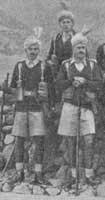INTRODUCTION
 From the dawn of time, it had been an established practice to kill the enemy’s leaders, so that they would lose heart and give up. Though modern armies were a little more sophisticated, with a command structure that could - and often did - devolve from company officer, to N.C.O., during the Great War the attrition rate amongst officers was un-acceptably high. Their gleaming Sam Browne Belts marked them out from their webbing-clad troops, giving German snipers an aiming mark. Very quickly, officers were directed to wear rankers’ Patt. ’08 W.E. and various adaptations are well in evidence in contemporary photographs.
From the dawn of time, it had been an established practice to kill the enemy’s leaders, so that they would lose heart and give up. Though modern armies were a little more sophisticated, with a command structure that could - and often did - devolve from company officer, to N.C.O., during the Great War the attrition rate amongst officers was un-acceptably high. Their gleaming Sam Browne Belts marked them out from their webbing-clad troops, giving German snipers an aiming mark. Very quickly, officers were directed to wear rankers’ Patt. ’08 W.E. and various adaptations are well in evidence in contemporary photographs.
As officers’ accoutrements were private purchase, there are no LoCs, or Priced Vocabularies to help with establishing a time-line as to dates of introduction. There is more detail to be found in contemporary advertisements, but too few of those have been noted, that can be placed in a chronological sequence. What seems certain is that manufacturers and military outfitters were quick to identify a “business opportunity”, on a far larger scale than had been seen during the Second Boer War.
Distinctive and different patterns exist: a canvas covered, leather Sam Browne and several all-canvas patterns, that loosely approximate a Sam Browne belt. Since the canvas covered variant - for which KW can now apply a trade name - used an existing design, it is felt this was the first commercial design offered, followed by the all canvas type. Again, it has to be assumed that Mills wanted a “market share” and they offered a version of Patt. ’08 W.E., but tailored specifically for officers. It is likely that Mills were following up the War Office instruction that officers should use Patt. ’08, so they would have wanted to improve on this. Mills had long since moved-on from Patt. ’08, with lighter-weight infantry designs in use with such as Canada (see Patt. ’13 section) and Belgian M-1915 W.E.. They therefore put together a specific design for officers, based on these principles.
 An analysis of contemporary Great war photographs reveal that very few of these commercial patterns actually saw use. Far more show adaptations of Patt. ’08 and it is not until post 1918, that widespread use becomes obvious. Dress Regulations continued to list Sam Browne Belts up until 1934, but Standing Orders were within the remit of the Colonel. Thus, on a regimental basis, groups of officers can be seen all wearing Mills Web Equipment for Officers (W.E.O.), as the Standing Orders invariably required officers to be equipped uniformly. A very small number of photographs show the canvas covered Sam Browne pattern, the “design of choice” being Mills’ W.E.O.. This is always on Foreign Service – a few instances amongst the Army of Occupation of the Rhine, but most being in India, particularly on the North-West Frontier. The photo at right shows the officers of the 2nd Battalion, 7th Rajput Regiment, in Web Equipment, Officers, on active service in Waziristan, 1937.
An analysis of contemporary Great war photographs reveal that very few of these commercial patterns actually saw use. Far more show adaptations of Patt. ’08 and it is not until post 1918, that widespread use becomes obvious. Dress Regulations continued to list Sam Browne Belts up until 1934, but Standing Orders were within the remit of the Colonel. Thus, on a regimental basis, groups of officers can be seen all wearing Mills Web Equipment for Officers (W.E.O.), as the Standing Orders invariably required officers to be equipped uniformly. A very small number of photographs show the canvas covered Sam Browne pattern, the “design of choice” being Mills’ W.E.O.. This is always on Foreign Service – a few instances amongst the Army of Occupation of the Rhine, but most being in India, particularly on the North-West Frontier. The photo at right shows the officers of the 2nd Battalion, 7th Rajput Regiment, in Web Equipment, Officers, on active service in Waziristan, 1937.
For users of pistols, as opposed to officers, the requisite Pistol cases and Ammunition pouches, together with Brace attachments were designed for use with (not as part of) Patts. ’03, ’08 and ’14 and these are described in the relevant sections of Karkee Web. Between the two World Wars, Web Equipment, Royal Arillery and the four trials models of the 1930s all provided permutations for pistol users, whether ranker or officer. The introduction of Patt. ’37 W.E. was the final death-knell for Sam Browne as a field equipment. The new pattern of webbing had provision for pistol users, from the outset (not as an afterthought, as with Patts. ’08 and ’14). It established the norm for all Patterns which followed – W.E. Patts. ’40, ’44, ’58 and P.L.C.E. ’90.
© R.J. Dennis, March 2009